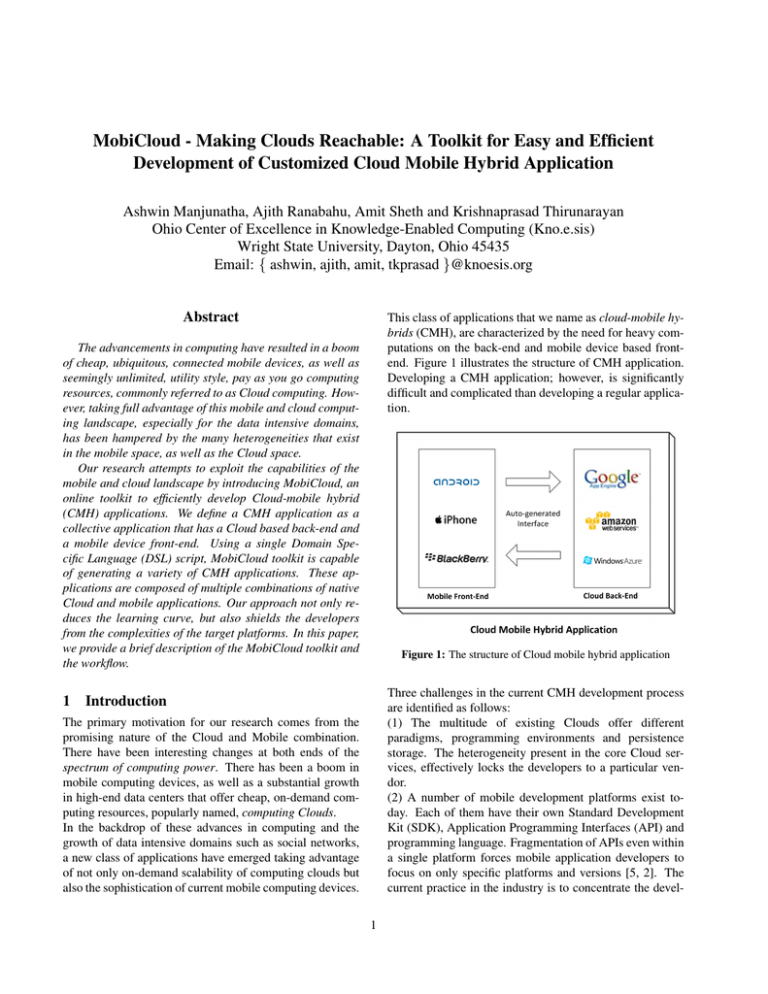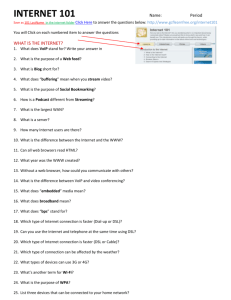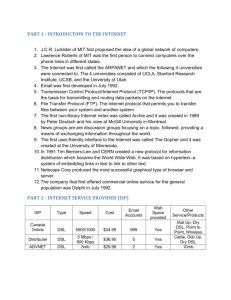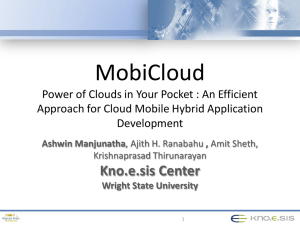MobiCloud - Making Clouds Reachable: A Toolkit for Easy and... Development of Customized Cloud Mobile Hybrid Application
advertisement

MobiCloud - Making Clouds Reachable: A Toolkit for Easy and Efficient
Development of Customized Cloud Mobile Hybrid Application
Ashwin Manjunatha, Ajith Ranabahu, Amit Sheth and Krishnaprasad Thirunarayan
Ohio Center of Excellence in Knowledge-Enabled Computing (Kno.e.sis)
Wright State University, Dayton, Ohio 45435
Email: { ashwin, ajith, amit, tkprasad }@knoesis.org
Abstract
This class of applications that we name as cloud-mobile hybrids (CMH), are characterized by the need for heavy computations on the back-end and mobile device based frontend. Figure 1 illustrates the structure of CMH application.
Developing a CMH application; however, is significantly
difficult and complicated than developing a regular application.
The advancements in computing have resulted in a boom
of cheap, ubiquitous, connected mobile devices, as well as
seemingly unlimited, utility style, pay as you go computing
resources, commonly referred to as Cloud computing. However, taking full advantage of this mobile and cloud computing landscape, especially for the data intensive domains,
has been hampered by the many heterogeneities that exist
in the mobile space, as well as the Cloud space.
Our research attempts to exploit the capabilities of the
mobile and cloud landscape by introducing MobiCloud, an
online toolkit to efficiently develop Cloud-mobile hybrid
(CMH) applications. We define a CMH application as a
collective application that has a Cloud based back-end and
a mobile device front-end. Using a single Domain Specific Language (DSL) script, MobiCloud toolkit is capable
of generating a variety of CMH applications. These applications are composed of multiple combinations of native
Cloud and mobile applications. Our approach not only reduces the learning curve, but also shields the developers
from the complexities of the target platforms. In this paper,
we provide a brief description of the MobiCloud toolkit and
the workflow.
1
Figure 1: The structure of Cloud mobile hybrid application
Three challenges in the current CMH development process
are identified as follows:
(1) The multitude of existing Clouds offer different
paradigms, programming environments and persistence
storage. The heterogeneity present in the core Cloud services, effectively locks the developers to a particular vendor.
(2) A number of mobile development platforms exist today. Each of them have their own Standard Development
Kit (SDK), Application Programming Interfaces (API) and
programming language. Fragmentation of APIs even within
a single platform forces mobile application developers to
focus on only specific platforms and versions [5, 2]. The
current practice in the industry is to concentrate the devel-
Introduction
The primary motivation for our research comes from the
promising nature of the Cloud and Mobile combination.
There have been interesting changes at both ends of the
spectrum of computing power. There has been a boom in
mobile computing devices, as well as a substantial growth
in high-end data centers that offer cheap, on-demand computing resources, popularly named, computing Clouds.
In the backdrop of these advances in computing and the
growth of data intensive domains such as social networks,
a new class of applications have emerged taking advantage
of not only on-demand scalability of computing clouds but
also the sophistication of current mobile computing devices.
1
opment efforts on selected mobile platforms, leaving out a
significant portion of devices and platforms.
(3) Developing the back-end and front-end as separate components require managing the communication interfaces.
The presence of Remote Procedure Calls (RPC) makes the
whole development process tedious, even with an arsenal of
sophisticated tools at a developer’s disposal. The separation
of the front-end and the back-end is also a source of version conflicts with Clients and Services where the service
API has to be maintained at the level of the least capable
client. Introducing changes to the service API would break
the existing clients requiring frequent updates, a common
problem faced by many of the mobile application vendors.
We present a solution where CMH applications are developed using a DSL in a platform agnostic fashion. Platform specific artifacts are later generated utilizing this DSL.
We demonstrate our current toolkit, capable of generating
code for four target platforms using a single DSL script.
Treating a CMH application as a single entity and leaving
out the details of generating corresponding Cloud and mobile artifacts to the toolkit not only reduces the complexity
significantly but also facilitate portability. Auto generating
the communication interfaces also shields the developers
from the heterogeneities of each of the platforms as well
as lengthy debug cycles of remote procedure calls (RPC).
Further details of the MobiCloud platform is available in
the MobiCloud technical report [4].
2
Technology
The core contribution in our work is the MobiCloud DSL
and the associated toolkit. The toolkit is capable of generating code for the following four target platforms.
•
•
•
•
Android platform (v 1.5)
Blackberry platform (v 4.5)
Google Appengine
Amazon EC2
The DSL is based on the Model-View-Controller (MVC)
design pattern. We have presented the philosophy and further details of the design of this DSL in the MobiCloud technical report [4].
We now take an example applications and demonstrate
the capabilities of our toolkit.
2.1
Helloworld example
Listing 1: The DSL script for the hello world application
r e c i p e : h e l l o w o r l d do
metadata : i d => ’ h e l l o w o r l d −app ’
model : g r e e t i n g ,
{ : m e s s a g e => : s t r i n g }
controller : sayhello
do
action : retrieve , : greeting
end
view : s h o w g r e e t i n g ,
{ : models = >[: g r e e t i n g ] ,
: c o n t r o l l e r => : s a y h e l l o ,
: a c t i o n => : r e t r i e v e }
end
Listing 1 depicts the DSL script for the Hello world application. This script generates the following components.
(1) A model with only one attribute.
(2) A controller with only one action.
(3) A view demonstrating a basic user interface.
We now describe the translations in detail for the hello
world application. Although we use this hello world
application to describe the salient features of this language,
it is not an exhaustive demonstration of all the possible
options of this DSL. Some extended sample applications
that demonstrate advanced capabilities of the DSL are
available at [3].
Back-end
1. A Google Appengine (GAE) compatible Java Web application with data storage capabilities.
2. A pure Java Servlet / JSP based Web application
with data storage capabilities compatible with Amazon EC2. Being pure signifies that only standard Java
libraries are used in the generated code.
Front-end
1. A native Android application containing XML based
auto generated user interfaces.
2. A native Blackberry application containing Java based
auto generated user interfaces.
For the back-end, i.e., the Cloud portions of the application,
the following artifacts are generated.
1. A set of bean classes for the models that optionally include the Java Data Object (JDO) standardized annotations. Each of the beans represent an implementation
of the relevant model description.
2. A set of JSP based HTML views that mimic the mobile
UI. The intention of this UI is to act as a testing tool.
3. The implementation of a relevant persistence manager
class.
4. RESTful Web Service that manages inputs via HTTP
POST requests and responds with XML.
5. Platform specific configuration files (e.g.
the
appengine-web.xml file required by GAE).
The front-end, i.e., the mobile portion of the application
consists of the following artifacts.
1. An optional set of bean classes for the models depending on the platform requirements. For some platforms
the beans are omitted.
2. A set of UI classes, event handlers and related artifacts
depending on the platform for each of the views.
3. An Index view that acts as the default entry point to the
application.
4. Web service access classes that use platform specific
communication libraries.
5. XML parsing code that use platform specific XML
processing libraries. The generated code is based on
the specific XML format followed by the back-end serializer.
6. Platform specific configuration and descriptor files
(e.g. the AndroidManifest.xml file required by the Android platform).
The generators also output an Ant1 file capable of building deployable artifacts. To execute this Ant build, the relevant SDK may need to be configured in the developers computer.
In this specific example, the hello world GAE application consists of the following important artifacts.
(1) Greeting.java: The bean corresponding to the model
definition of Greeting. Greeting consists of a single string
attribute that represents the message.
(2) Sayhello.java: An HTTP Servlet [1] corresponding to
the controller definition. This servlet handles the :retrieve
action by generating an XML output of the list of Greeting
items in the data store. The XML output is generated by a
JSP.
Similarly, in the mobile side, the hello world Android
application consists of the following major artifacts.
(1) Index.java: An Android activity that acts as the entry
point to the application. Provides access to all the other
functions, in this case, to view the greeting message.
(2) Corresponding XML files that form the UI.
(3) AndroidManifest.xml: Android specific configuration
file, considered mandatory to deploy an Android application.
3
Figure 2: Step 1 : The online editor for the DSL with syntax
highlighting and other text editor support
Figure 3: Step 2 : Selection of target platforms
System Implementation
The system is implemented in Ruby in order to take advantage of the existing Ruby parser and interpreter. Figure
5 illustrates major components of the system. The parser is
a top down parser that takes the DSL scripts (a.k.a. recipes)
and converts them into in-memory object representations.
These object models are then converted into platform specific code using the corresponding generator and the associated templates. To support a new platform, the system
requires only an additional generator targeted towards the
new platform.
The generator tool, complete set of sample programs and
XML version of all results, is available on the Kno.e.sis
1 http://ant.apache.org
Figure 4: Step 3 : Download the generated applications
Figure 5: System Implementation Components and Flow
Website [3]. A detailed evaluation is available in the technical report [4].
4
Tool Workflow
The workflow for the MobiCloud online tool to create
this application is kept as simple as possible. Figures 2,3
and 4 illustrate the different steps of the workflow.
• Step 1 of the workflow is to enter the DSL text as illustrated in Figure 2. The online editor supports text
highlighting and other text editing actions. As part of
this step we plan to add a drag-and-drop graphical UI
in the future.
• Step 2, as shown in Figure 3, allows the selection of
the target platforms. Users can select various combinations of Cloud and mobile platforms in this step.
• Step 3 enables the users to download the generated
code in compressed form. This is illustrated in Figure
4. The generated code can be readily compiled and deployed using an appropriately configured development
environment.
5
Conclusion
The conditions are right for a boom in CMH applications and our contributions stand to provide a well-defined
methodology to exploit them. The use of DSL shields developers from minor details of the target platform and reduces the number of defects by auto-generating communication interfaces. Although the DSL and the toolkit presented in this research has room for many improvements, it
has clearly demonstrated the applicability of DSLs in both
Cloud and Mobile spaces.
References
[1] D. Coward. Java servlet specification version 2.3. Sun Microsystems, 2001.
[2] O. Kharif. Android’s spread could become a problem.
http://bit.ly/d0lHG8.
[3] A. Manjunatha, A. Ranabahu, A. Sheth, and K. Thirunarayan.
MobiCloud. Available online at http://knoesis.org/mobicloud
- Last accessed September 12th 2010.
[4] A. Manjunatha,
A. Ranabahu,
A. Sheth,
and
K. Thirunarayan.
MobiCloud Technical Report.
http://knoesis.wright.edu/library/publications/MobiCloud.pdf
- Last accessed September 12th 2010.
[5] R. Moll. Knowing is half the battle, 2009. Available online at
http://bit.ly/cvvWaR - Last accessed September 12th 2010.



